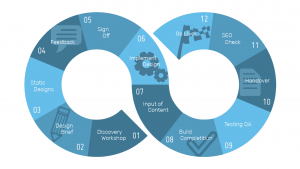Websites need to be continually updated. Recent increases in mobile use makes 2015 something of a milestone for online companies. Surprisingly, there are still thousands of small businesses without any online presence. Another large percentage of small businesses have failed to keep their websites updated.
50% of small businesses have seen inaccurate listings for their own establishments, with errors ranging from telephone numbers and addresses to operating hours. 70% of small business owners claim they are unable to manage listings on consumer sites. Possibly the scariest statistic is this: less than a quarter of small businesses understand how search engines, web content, and list sites drive traffic and result in sales. Ouch.
Though not having a website, or having a site with old content, is not a business failing, it can make doing business more difficult. The incredible thing about this technology is the immediacy with which it can help you and the fact that it’s never too late to start.
Why Websites Matter

Is this cause for discussion? Absolutely. As of July of last year, 55% of small businesses still had not gotten around to launching a website. Many of these companies were still posted on list and review sites, but the companies were not aware of their online presences and failed to check these sites for accuracy.
Everyone needs a site, even if you own a hot dog cart or a taco truck. If your mall kiosk is part of a chain, it needs its own landing page. Why? Between 40-50% of mobile searches are for location-based services, including food. When customers have made up their minds about where to eat, that is where they tend to go. Since mobile phones are owned by 80% of adults, guess where the search begins? It is easier than ever to type “gnocchi” into your phone and let its GPS locate all registered food vendors that make pasta.
Even cash-strapped companies and tightly-budgeted startups can afford to launch a webpage. Creating a site is easier than ever before. Many hosting services like Wix and Weebly require absolutely no coding skills and are free to host and publish content. Google offers to host websites for free.
Keep Your Site Current
The internet is always evolving. Your rank is dictated by search engines, and the rules for how you place in those rankings are in constant flux. Businesses must, must, must update their websites and keep up with current trends. The companies that adopt new technologies to streamline their processes are the ones who will be able to handle growth in the future. Half of small business owners have failed to launch a website, and even fewer are taking advantage of the following technologies:
- Point-of-sale systems and tablet credit card swipes (25%)
- Acquisition marketing (14%)
- Customer relationship management (34%)
- Logistics and scheduling software (39%)
- Traffic analytics (56%)
If you are a small business owner reading this article, take heart. Those low numbers are great news for you, because now is the time to get ahead in your market! In the United States alone, there are 23 million small businesses that make up 54% of sales in the country. If you manage to get on the train before it leaves the station, you will be well ahead of the curve.
Let’s return to search engine changes. Google updates the way searches bring traffic to websites over 500 times per year. Since successful landing pages convert traffic to sales, the way a website interacts with Google determines how people find the site. Keeping up with the times is absolutely necessary.
Making sure your website is updated directly relates to consumers’ perceptions of your brand, as well. Trends are changing all the time. In 2015, trends are about responsive design for mobile customers, massive background images with minimal text, and personalized content. Consumers without digital marketing knowhow may not be able to pinpoint why your site feels behind the times, but you can be sure they will judge your brand. Your customers are not being malicious; it is human nature. Customers open multiple tabs when searching Google, and the bounce rate for underdeveloped and outdated sites is much higher.
What Does a Website Do For You?

There are endless ways websites can save you time and money, so we will focus on some crucial basics:
- Cut down on waste. The cost of producing brochures, image-heavy promotional material, and other goods can be substantially mitigated by switching to a website.
- Increase brand value. Did you know banks often make loan and loan interest decisions based on web presence? An active social media campaign and stellar website increases your company’s perceived value.
- Send a strong message. What happens when you drive past a retail store or small business? You get a sense of the services they offer and little else. A website is your chance to tell your story, showcase your brand, and win customers’ hearts. It is a way to have a one-on-one conversation with consumers without direct engagement.
Businesses that apply these best practices and are constantly looking for opportunities to improve will enjoy clearer communication, better branding, and a marked increase in business. Out of the 2.4 billion people currently using the internet on a daily basis, 9 in 10 have made a purchase or interacted with a company within the last year. The internet is shaping almost all business decisions, even if customers need to enter a store to make purchases. Stay up to speed on these developments, and you too can reap the myriad rewards.
(202)






